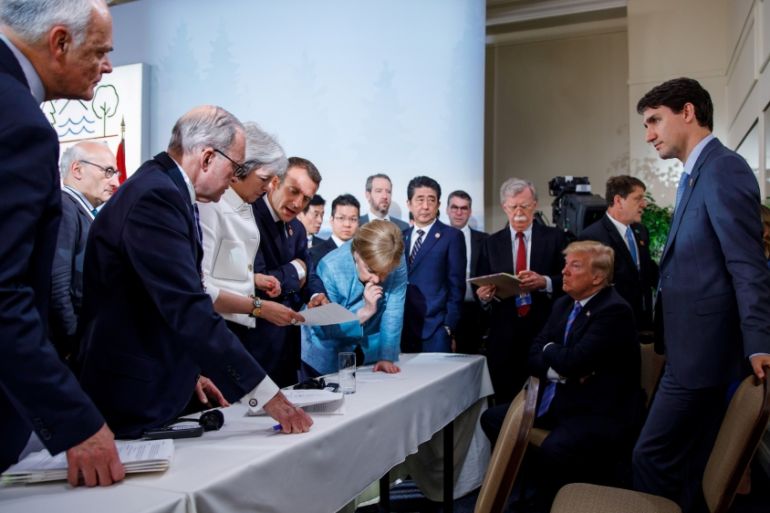From ‘American First’ to ‘America Alone’
Trump’s trade protectionism isn’t only misguided, but also irresponsibly dangerous.

While the world rejoiced over the landmark US-North Korea summit in Singapore, which raised hopes for long-elusive peace on the Korean Peninsula, the Trump administration quietly opened a new battlefront.
In what appears to be the initial steps of an all-out trade war against the world, the US government has slapped even newly minted allies such as India with unilateral tariffs.
Keep reading
list of 4 itemsKey takeaways from day 18 of Donald Trump’s New York hush money trial
Who benefits from US tariffs on Chinese imports? Experts weigh in
‘Any time, any place’: Biden and Trump agree to June and September debates
Despite its budding bilateral strategic relations with Washington, New Delhi failed to secure a waiver of exemption from US trade sanctions. All other major developing countries, from Indonesia and Mexico to Brazil and Turkey, are also expecting the same fate.
Unless US President Donald Trump revisits his policy, the world may suffer from a 70 percent reduction in global trade and up to 4 percent contraction in the global Gross Domestic Product (GDP).
In his efforts to promote “America First” policies, Trump risks spelling the end of his country’s global leadership.
The triumph of the hawks
Only a few months ago, many experts were dismissive of Trump’s threats against major US trade partners. Many thought that the president, as a supposedly cosmopolitan businessman from New York, should know and be sensitive to the concerns of big business.
In the first months of his administration, Trump seemed to be going down that path. He appointed former Wall Street executives to his administration, established a special advisory council filled with Silicon Valley luminaries and passed massive tax breaks for big business.
Despite the unceremonious departure of Steve Bannon earlier, other nationalist-protectionist voices such as Peter Navarro, Director of the White House National Trade Council, remained in firm position of influence. They skillfully managed to appeal to the pugnaciously unilateralist streak in Trump, convincing him that America is in a strong position to extract concessions from other countries through coercive trade measures. Ever-contemptuous of liberals, Trump welcomed a trade war as a way to defy the pro-trade establishment and test the limit of his power to bend the world to his will.
Then globalist and pro-trade voices within his administration gradually diminished. Gary Cohen, his chief economic adviser and former Goldman Sachs executive, resigned in March amid growing frustrations with the protectionist-isolationist tendencies of the president.
Just days after, Trump fired his Secretary of State Rex Tillerson, another globalist and former Exxon Mobil chief, who hopelessly emphasised diplomacy and trade over confrontation.
The White House is currently dominated by hawkish conservatives such as Secretary of State Mike Pompeo and National Security Adviser John Bolton, as well as staunch protectionists such as Chief Trade Adviser Peter Navarro.
The ‘America Alone’ policy
As a result, for the first time since his ascent to presidency, there are practically zero checks on Trump’s pugnacious and protectionist tendencies. As one of Trump’s senior aides put it, the new doctrine is “no friends, no enemies,” but only American interest.
For the “art of the deal” president, “[p]ermanent destabilization creates American advantage”. Other countries, whether weak or strong, ally or rival, will eventually “see over time that it doesn’t pay to argue with us”. Trump seeks nothing short of submission.
It’s precisely this full-fledged belligerent mindset that has driven Washington to invoke “national security” concerns to impose tariffs on some of its oldest friends, including Canada. In its latest joint statements, the G7 summit of leaders and finance ministers singled out the US as a major source of concern for international trade and climate change. French President Emmanuel Macron even raised the prospect of evicting it from the G7.
Developing countries have also lashed out at Trump’s destructive economic decisions. Thus, in a surreal turn of events, the US under Trump, has managed to unite the two competing blocs of G7 and the BRICS (Brazil, Russia, India, and China) against itself.
Yet, beyond the massive soft power disaster for the US, what is at stake is millions of trade-sensitive jobs, as escalating tariffs ripple through highly globalised economies from Asia to the Americas and Europe.
From the Mid-Continent Nail, the US’s’s largest nail manufacturer, in Missouri to Borusan Mannesmann, a steel pipe manufacturer, in Texas, workers have been losing their jobs amid slumping demand for American products due to escalating trade wars. Economists estimate that as many as 146,000 Americans will lose their jobs, with millions more facing precarious employment prospects, unless Trump reverses his policy. Other major trading nations, from China to India and the European Union, could eventually choose to bypass the US by strengthening trade and financial linkages among each other. But given the US’s’s dominance of the world of finance, and its position as the world’s biggest economy, Washington’s protectionism will have disproportionately negative effect on everyone for the foreseeable future.
From single-digits, average tariff rates among major industrialised countries could escalate to above 40 percent , echoing the Great Depression period in early-20th century when trading nations pushed each other to the brink of war with tit-for-tat tariffs.
The trade shock brought about by Trump will only exacerbate internal systemic problems of both industrialised and emerging economies, likely provoking nationalist retribution from the US’s’s trading partners. The US’ trade protectionism isn’t only misguided, but also irresponsibly dangerous.
The views expressed in this article are the author’s own and do not necessarily reflect Al Jazeera’s editorial stance.
